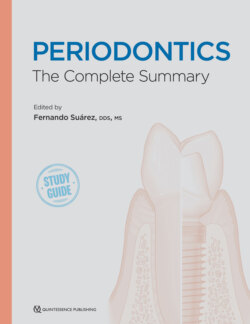Читать книгу Periodontics - Fernando Suarez - Страница 64
На сайте Литреса книга снята с продажи.
Local effects
ОглавлениеAt the local level, smokers demonstrate increased supragingival4 as well as subgingival calculus formation.5 Additionally, the presence of nicotine has an effect on gingival fibroblasts, demonstrating an increase in gingival mediated collagen degradation. This action is mediated through the activation of matrix metalloproteinases (MMPs) and redistribution of the tissue inhibitors of metalloproteinases (TIMPs) to the cell membrane. Interestingly, this action is enhanced by the presence of Porphyromonas gingivalis.6 With regard to the often observed fibrotic clinical appearance of the gingival tissues in smokers, in vitro investigations have demonstrated a possible explanation by the increase in the production of CCN2/CTGF (connective tissue growth factor) protein and consequently Type I collagen production.7 The vasoconstriction and fibrosis on the gingival tissues often result in decreased bleeding on probing (BOP) even in the presence of bacterial plaque and calculus.8
Smokers also present with increased radiographic bone loss compared with nonsmokers, and there is a dose-dependent relationship: The odds of heavy smokers having severe bone loss are higher (odds ratio [OR] 7.28) compared with light smokers (OR 3.25).9 These detrimental effects are also observed in populations that maintain good levels of oral hygiene. Cross-sectional studies demonstrated that smokers had significantly reduced bone levels compared with nonsmokers, with the observed amount of bone loss occurring in a shorter time frame in smokers.10 Similar conclusions were obtained when evaluating the bone levels of a different population (Swedish hygienists) through the assessment of bitewing radiographs. Smokers had the highest amount of radiographic bone loss compared with nonsmokers or former smokers.11
0Van Winkelhoff et al12 investigated the prevalence and levels of periodontal pathogens in both smokers and nonsmokers who were treated for periodontal disease as well as untreated populations. A higher prevalence of periodontal pathogens was noted in treated and untreated smokers in comparison with the respective nonsmoking populations. Based on these findings, the authors suggested integrating the use of systemic antibiotics in patients who do not exhibit a favorable response to initial treatment.12 Haffajee and Socransky13 performed a similar study, implementing DNA-DNA hybridization. Subjects were divided based on two criteria: (1) according to their smoking habits in current smokers, former smokers, and nonsmokers; (2) according to their periodontal status in periodontally healthy, well-maintained, and periodontitis patients. Current smokers had larger proportions of sites colonized by periodontal pathogens.13 Zambon et al14 came to similar conclusions after conducting a large cross-sectional study using immunofluorescence. Tannerella forsythia and Aggregatibacter actinomycemetcomitans were more likely to be identified in the subgingival microflora of smokers. Furthermore, there was a dose-dependent relationship between the risk of T forsythia infection and the number of pack-years.14
